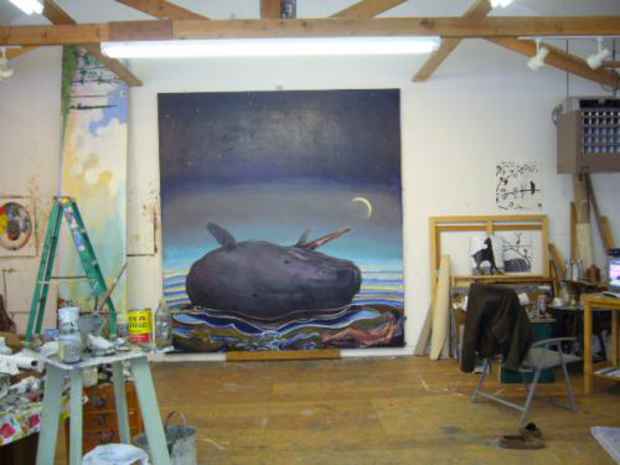Verne Dawson Exhibition
Gavin Brown's Enterprise

This event has ended.
Hamlet. Do you see yonder cloud that’s almost in shape of a camel?
Polonius. By the mass, and ’tis like a camel, indeed.
Hamlet. Methinks it is like a weasel.
Polonius. It is backed like a weasel.
Hamlet. Or like a whale?
Polonius. Very like a whale.
Verne Dawson’s art operates on the basis that perception is inconsistent, and reality phantasmagorical. Look closely, or for any length of time, and the pictorial components start to morph from one thing or feeling into another. Nowhere is this more evident than in the transformational properties of the paint itself, which can change from pigment and oil into a mushroom cloud, a brushstroke, a whale or pretty patterns. The images are simultaneously droll, tragic, innocent and complex. But underlying all this fluctuation is a sense of order and meaningfulness.
In a 2002 interview with Maurizio Cattelan, Dawson was asked how he felt about the concepts of time and the past. He made a number of observations in reply, some of which are collated below:
“In the South there's a saying, The past isn't dead. The past isn't even past”… “It is a thrill of recognition to walk down Broadway, the old Indian trail of Manhattan”…“What I'm really interested in are the methods, stories and symbols that we use to mark time. The very structure of our lives is predicated upon the celestial movements of sun, moon, planets and stars. Cross-referenced with the study of folklore, religion, and popular culture, a compelling case can be made for a continuity of culture from 40,000 years ago to the present. [But time] is also the curse and the inevitability of death.”
Ideas such as these inform the paintings gathered for this current exhibition. Cross-references are everywhere, including to popular culture, in the form of the psychedelic effects that sometimes surface. Trippy fairytales and biblical myths — Eve in the Garden of Eden, Goldilocks and the Three Bears— may bring to mind moments from the viewer’s own childhood, and other remembrance of things not past. Memory is an act of the imagination. The past consists of multiple pasts. And it isn’t past.
The orientation often turns skyward, where celestial movements can be felt or observed, even from within the belly of a great fish. Dawson served in the navy. The sky in the paintings is the same one that the artist, and Jonah, navigated by. It’s the same sky above you. The boat on a stormy sea might be bound for Tarshish or the Persian Gulf. And it might also happen that this is the frigate on which the artist once sailed. Perhaps the pictures are meditations on nature, and the nature of self- portraiture.
The paintings celebrate the fact that they belong to the ancient and unfolding history of art. Always there is the thrill of recognition, that the past isn’t dead. One way, that the recognition of this presents itself to the mind of the viewer, is through the diversity of allusions made by the paintings.
Media
Schedule
from May 08, 2009 to June 20, 2009
Opening Reception on 2009-05-08 from 18:00 to 20:00